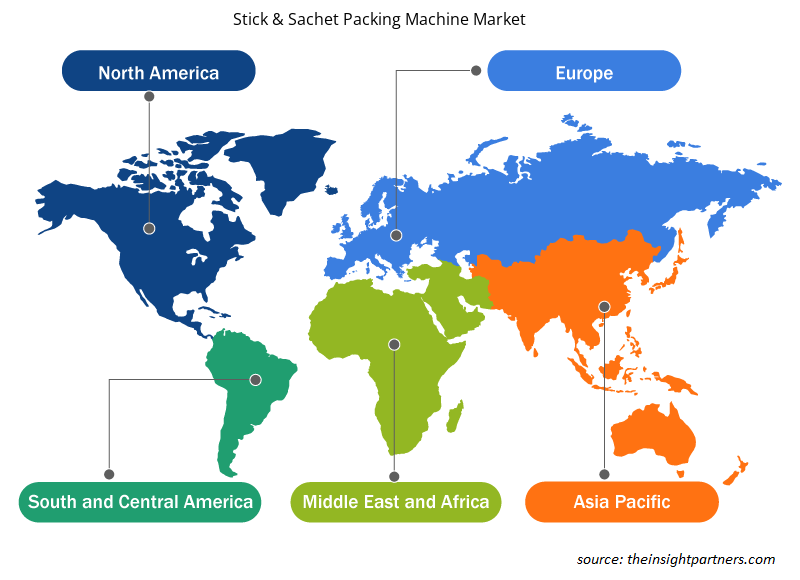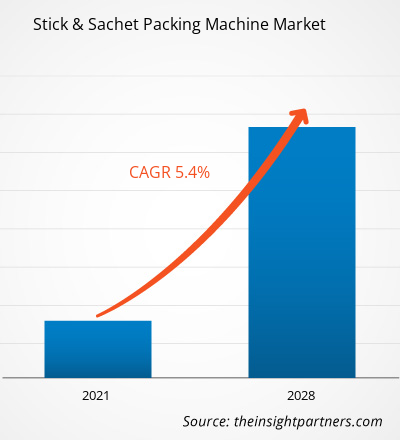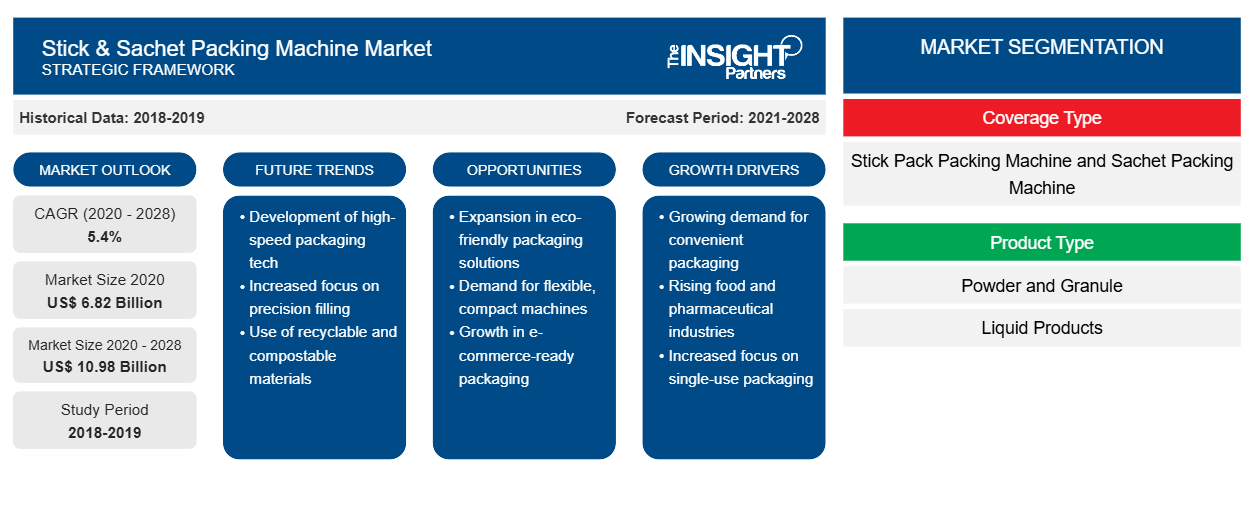Il mercato delle macchine confezionatrici per stick e bustine è stato valutato a 6.819,38 milioni di dollari USA nel 2020 e si prevede che raggiungerà i 10.978,92 milioni di dollari USA entro il 2028. Si stima che registrerà un CAGR del 5,4% durante il periodo di previsione.
La rapida industrializzazione globale, le crescenti preferenze dei consumatori per i prodotti confezionati, la crescita dell'industria alimentare e delle bevande, una crescente attenzione alla fornitura di servizi di manutenzione intelligenti e un'elevata ottimizzazione dei processi di confezionamento sono alcuni fattori che probabilmente stimoleranno la crescita di questo mercato durante il periodo di previsione. Nella proiezione sopra menzionata, l'evoluzione del settore dell'e-commerce e la prevalenza di canali di distribuzione potenziati offrono numerose opportunità per la crescita del mercato globale delle macchine confezionatrici per stick e bustine.
Gli stakeholder chiave nell'ecosistema del mercato globale delle macchine confezionatrici per stick e bustine sono i fornitori di materie prime, i produttori di macchine confezionatrici per stick e bustine e gli utenti finali. I fornitori di materie prime sono gli stakeholder iniziali nel mercato in quanto forniscono vari metalli, come acciaio, acciaio dolce, plastica, plastica rinforzata con fibra di vetro (GRP) e metalli ferrosi. Questi materiali migliorano la qualità dei componenti per prestazioni e durata migliori.
Personalizza questo report in base alle tue esigenze
Riceverai la personalizzazione gratuita di qualsiasi report, comprese parti di questo report, o analisi a livello nazionale, pacchetto dati Excel, oltre a usufruire di grandi offerte e sconti per start-up e università
-
Scopri le principali tendenze di mercato in questo rapporto.Questo campione GRATUITO includerà analisi di dati che spaziano dalle tendenze di mercato alle stime e alle previsioni.
Impatto della pandemia di COVID-19 sul mercato delle macchine confezionatrici per stick e bustine
L'epidemia di COVID-19 ha avuto un impatto negativo sulle aziende manifatturiere in tutto il mondo, ma il mercato globale delle macchine confezionatrici per stick e bustine è rimasto relativamente inalterato. La maggior parte delle aziende di imballaggio è pienamente operativa con una maggiore capacità, mentre alcune stanno ancora pianificando di aumentare la produzione. D'altro canto, i principali produttori pianificano di standardizzare le attrezzature utilizzando nuove tecniche per aumentare le vendite sul mercato.
Inoltre, i processi di produzione nella maggior parte dei paesi interessati, come Cina, Italia settentrionale, Germania e Stati Uniti, procedono senza intoppi, sostenendo la crescita del mercato globale delle macchine confezionatrici per stick e bustine.
Approfondimenti sul mercato globale delle macchine confezionatrici per stick e bustine
Tecnica di efficacia complessiva delle apparecchiature (OEE)
La necessità di macchine per l'imballaggio di integrarsi con i processi di produzione a monte ha portato allo sviluppo di tecniche di automazione per diversi settori. La tecnica dell'efficacia complessiva delle apparecchiature (OEE) è utilizzata nelle operazioni di imballaggio snello per controllare il processo di imballaggio. Le operazioni di imballaggio snello sono ora ampiamente utilizzate a causa della crescente necessità di pasti confezionati, farmaci e trattamenti continui e dell'elevata spesa per prodotti di marca, che accelera il mercato globale delle macchine per l'imballaggio di stick e bustine. Inoltre, le aziende di e-commerce in India, Indonesia, Cina e Stati Uniti stanno introducendo pratiche di imballaggio snello, alimentando significativamente la domanda di macchine per l'imballaggio di stick e bustine.OEE) technique is used in lean packaging operations to control the packaging process. Lean packaging operations are now widely used because of the increased need for packaged meals, continuous medications and treatments, and high spending on branded products, which accelerates the global stick & sachet packing machine market. Furthermore, e-commerce enterprises in India, Indonesia, China, and the US are introducing lean packaging practices, fueling the demand for stick and sachet packing machines significantly.
Gli imballaggi flessibili stanno diventando più popolari di altri tipi di imballaggi. Sono costituiti da sviluppi di mercato e fattori di crescita come e-commerce, stampa digitale e sostenibilità. I clienti sono disposti a pagare un prezzo elevato per caratteristiche di prodotto uniche rese possibili dagli imballaggi flessibili. Secondo la Flexible Packaging Association, oltre il 60% dei consumatori nordamericani è disposto a pagare di più per vantaggi tangibili e funzionali degli imballaggi come protezione del prodotto, facilità di trasporto ed efficienza della supply chain. Si prevede che tali fattori amplieranno il mercato delle macchine per l'imballaggio di stick e bustine.
Informazioni sul mercato globale delle macchine confezionatrici per stick e bustine basate sul tipo
In base al tipo, il mercato globale delle macchine confezionatrici stick & sachet è suddiviso in macchine confezionatrici stick pack e macchine confezionatrici sachet. Il segmento delle macchine confezionatrici stick pack è stato valutato a 4.026,08 milioni di $ USA nel 2020 e si prevede che raggiungerà 6.686,56 milioni di $ USA entro il 2028, con un CAGR del 5,7% durante il periodo di previsione.CAGR of 5.7% during the forecast period.
Approfondimenti sul mercato globale delle macchine confezionatrici per stick e bustine in base al tipo di prodotto
In base al tipo di prodotto, il mercato globale delle macchine confezionatrici stick e sachet è segmentato in polvere e granuli, prodotti liquidi e altri. Il segmento potenza e granuli ha guidato il mercato con una quota del 55,6% nel 2020. Si prevede inoltre che rappresenterà il 57,3% del mercato totale entro il 2028.
Macchina confezionatrice per stick e bustine
Approfondimenti regionali sul mercato delle macchine confezionatrici per stick e bustine
Le tendenze regionali e i fattori che influenzano il mercato delle macchine confezionatrici Stick & Sachet durante il periodo di previsione sono stati ampiamente spiegati dagli analisti di Insight Partners. Questa sezione discute anche i segmenti e la geografia del mercato delle macchine confezionatrici Stick & Sachet in Nord America, Europa, Asia Pacifico, Medio Oriente e Africa e Sud e Centro America.

- Ottieni i dati specifici regionali per il mercato delle macchine confezionatrici per stick e bustine
Ambito del rapporto di mercato sulle macchine confezionatrici per stick e bustine
| Attributo del report | Dettagli |
|---|---|
| Dimensioni del mercato nel 2020 | 6,82 miliardi di dollari USA |
| Dimensioni del mercato entro il 2028 | 10,98 miliardi di dollari USA |
| CAGR globale (2020 - 2028) | 5,4% |
| Dati storici | 2018-2019 |
| Periodo di previsione | 2021-2028 |
| Segmenti coperti |
Per tipo di copertura
|
| Regioni e Paesi coperti |
America del Nord
|
| Leader di mercato e profili aziendali chiave |
|
Densità dei player del mercato delle macchine confezionatrici per stick e bustine: comprendere il suo impatto sulle dinamiche aziendali
Il mercato delle macchine confezionatrici Stick & Sachet sta crescendo rapidamente, spinto dalla crescente domanda degli utenti finali dovuta a fattori quali l'evoluzione delle preferenze dei consumatori, i progressi tecnologici e una maggiore consapevolezza dei vantaggi del prodotto. Con l'aumento della domanda, le aziende stanno ampliando la propria offerta, innovando per soddisfare le esigenze dei consumatori e capitalizzando sulle tendenze emergenti, il che alimenta ulteriormente la crescita del mercato.
La densità degli operatori di mercato si riferisce alla distribuzione di aziende o società che operano in un particolare mercato o settore. Indica quanti concorrenti (operatori di mercato) sono presenti in un dato spazio di mercato in relazione alle sue dimensioni o al valore di mercato totale.
Le principali aziende che operano nel mercato delle macchine confezionatrici per stick e bustine sono:
- Macchinari per imballaggio ARANOW, SL
- Ingeniería de Envasado Vertical SL
- IMA-Ilapak
- Körber AG
- Macchinari per imballaggio Matrix, LLC
Disclaimer : le aziende elencate sopra non sono classificate secondo un ordine particolare.

- Ottieni una panoramica dei principali attori del mercato delle macchine confezionatrici per stick e bustine
Approfondimenti sul mercato globale delle macchine confezionatrici per stick e bustine basate sull'utente finale
Sulla base dell'utente finale, il mercato globale delle macchine confezionatrici stick e sachet è suddiviso in alimenti e bevande, prodotti farmaceutici, prodotti chimici, cosmetici e altri. Il segmento alimenti e bevande è stato valutato a 2.627,18 milioni di dollari USA nel 2020 e si prevede che raggiungerà i 4.118,79 milioni di dollari USA entro il 2028.
I player del mercato globale delle macchine confezionatrici stick & sachet adottano varie strategie, come fusioni, acquisizioni e iniziative di mercato, per rimanere competitivi. Di seguito sono elencati alcuni recenti sviluppi dei principali player del mercato:
- Nel 2021, ARANOW Packaging Machinery, SL ha collaborato con AlliedFlex Technologies per incrementare le vendite in Nord America gestendo la linea di prodotti per macchinari per il confezionamento in stick pack.
- Nel 2022, Syntegon Technology GmbH sta ampliando il suo portafoglio di macchine per il confezionamento del caffè con la macchina per il confezionamento PMX per caffè macinato e chicchi interi. La macchina PMX può essere utilizzata per diversi formati di confezionamento. Inoltre, PMX elabora monomateriali riciclabili e riduce l'utilizzo di energia e materiali tramite il monitoraggio delle condizioni.
Profili aziendali elencati nel mercato globale delle macchine confezionatrici per stick e bustine
- Macchinari per imballaggio ARANOW, SL
- Ingeniería de Envasado Vertical SL
- IMA-Ilapak
- Körber AG
- Macchinari per imballaggio Matrix, LLC
- MESPACK, SL
- OMAG Srl
- SmartPac Verpackungsmaschinen GmbH
- Syntegon Tecnologia GmbH
- Universal Pack Srl
- Analisi storica (2 anni), anno base, previsione (7 anni) con CAGR
- Analisi PEST e SWOT
- Valore/volume delle dimensioni del mercato - Globale, Regionale, Nazionale
- Industria e panorama competitivo
- Set di dati Excel
Report recenti
Rapporti correlati
Testimonianze
Motivo dell'acquisto
- Processo decisionale informato
- Comprensione delle dinamiche di mercato
- Analisi competitiva
- Analisi dei clienti
- Previsioni di mercato
- Mitigazione del rischio
- Pianificazione strategica
- Giustificazione degli investimenti
- Identificazione dei mercati emergenti
- Miglioramento delle strategie di marketing
- Aumento dell'efficienza operativa
- Allineamento alle tendenze normative























 Ottieni un campione gratuito per - Mercato delle macchine confezionatrici per stick e bustine
Ottieni un campione gratuito per - Mercato delle macchine confezionatrici per stick e bustine